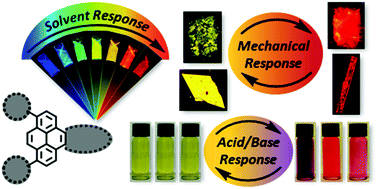Subtle substitution controls the rainbow chromatic behaviour of multi-stimuli responsive core-expanded pyrenes†
Abstract
Materials that respond to multiple environmental stimuli by altering a physical property such as colour are fundamental to development of smart devices. Five core-expanded pyrene derivatives are presented to demonstrate that substitution by ring-fusion and addition of distal groups controls responsiveness to mechanical force, solvent, and acid in both solution and solid-state. Contained herein is the first direct observation of the subtle intermolecular forces that govern crystal-to-crystal transition in a new class of mechanochromic pyrene. Shearing the solid controls the aggregation state, altering the yellow-fluorescent J-type aggregated pristine material to orange-fluorescent individual monomers. X-ray diffraction analysis of each crystalline polymorph against a close structural analogue revealed that this force-induced behaviour was permitted by slight differences in distal substitution. In solution, the five core-expanded pyrenes display a rainbow of fluorescent colours in response to solvent polarity and acid. The breadth and location on the rainbow spectrum depends upon the style of ring-fusion as well as distal substitution on pyrene. Responsiveness to acid is mirrored in the solid-state – acid sensing is ambiently-reversible simply over time, without the need for additional base. Self-regenerating behaviour is permitted by only one of the two styles of ring-fusion borne by the core-expanded pyrenes.



 Please wait while we load your content...
Please wait while we load your content...